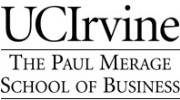
Career search for an MBA is a full time job. As great as my program is, we do not get the parade of major companies recruiting on-campus like some other schools. We get a number of the local majors, but we do not get the Googles and Amazons of the world. That is the challenge of being part of a building process. No doubt in my mind, Merage is moving in the right direction, but attracting major companies will be a long process for this school.
In hindsight, as a international, I may have more aggressively pursued a major MBA program to make my career search easier. Internationals have enough hurdles to cross as it is. I strongly believe Merage is the best educational fit for me, but if you want to go to a big name company you will need to do alot of networking as you will see below.
The good news is that I accepted a position this week with Experian; and it is a really fantastic position. I will be a Synergy & Innovation Manager. I am part of a 4 person team led by an EVP who reports directly to the Americas CEO. Our task is to help Experian's 16 business lines improve their cross-communication and collaboration to spur innovation and revenue growth for the company.
As a company grows it naturally forms groups who solely focus on their business idea. While focusing on their idea, they not really interact with the other lines. That is needed for the business to excel, but there comes a point when the revenue growth from those business lines slows down to a level below what is demanded from a successful company. New ideas must be spawned. Sharing information is the first step.
The next step for our team will be to identify great opportunities that arise from this information sharing and help build them into strong business lines in their own right. Huge challenges and a great opportunity with a great multi-national company that would not have been possible without Merage.
My job search process took alot of time. Internationals not only must demonstrate that they are the best candidate for the job, they must demonstrate they are worth the extra trouble over the next best candidate (a difficult proposition in this slowdown period that is seeing more candidates in the job pool). I classify my search in three categories: 1) Opportunities arising from Merage; 2) Opportunities from networking; and 3) Generic job board opportunities.
Opportunities that flow through Merage are prime opportunities. Those companies know about Merage's great program and are looking for people trained in that manner. We get a number of great companies coming to Merage like Yum Brands, Experian, Mervyn's, and Walt Disney. I credit our career center. They have made dramatic improvements and I am sure the quality of incoming companies will only improve.
The second way to drum up job opportunities is to network. This is incredibly important for all MBAs, but critically important for internationals. After the companies that come to your career center, these opportunities will be your best ones. Personally, I contacted alumni at my target companies, leveraged LinkedIN to find people in my extended network at these companies, and attended trade shows in my industry to make contacts. At the time I accepted the Experian offer, I was 2/3 the way through the interview process with Amazon. I got the opportunity to interview with Amazon by attending the Web2.0 trade show where I introduced myself to an Amazon recruiter and followed up with an email indicating my interest in a specific position.
The last way is a long shot for internationals, but we have nothing to lose: Follow job boards at specific companies and websites such as Monster.com. For this strategy, I recommend the shotgun approach - create a few generic resumes and cover letters for certain jobs and send them out to as many jobs that fit your interest. The resumes and cover letters should have as many key words as you can fit in them without sounding stupid (I call it recruiter keyword bingo). Don't expect a high response rate (maybe 1-2%), but just look at any response as a new networking opportunity. My experience saw 3 responses in an estimated 80-120 applications.
All three methods are important. You never know how or when you will resonate with a company. Even if you are rejected at one company, you should strive to build relationships with that company (I was rejected for another position at Experian). Finally, persistence and aggressiveness will win over talent any day. Call your alumni and extended networks in the companies your are interested in, create online profiles (I am sure my professional blog helped my manager better understand what I offered Experian), and keep applying. It is not easy, but it can happen if you make opportunities for yourself.
I am grateful for Merage focusing its curriculum on innovation. I think it has given me a number of tools that will improve the chances of success at this new position. I am nervous about going into a large, more political company. While I believe I have dramatically improved my diplomatic capabilities as a management consultant and at this program, I have not been true tested in this kind of environment. I am looking forward to the challenge and working with a small team dedicated to an incredibly important goal that I whole-heartedly believe in. Most of all, I am glad that Lindsey and I will have the opportunity to stay in Southern California a little longer. To everyone that supported us, we thank you and will keep you informed as we extend our California MBA Adventure.



